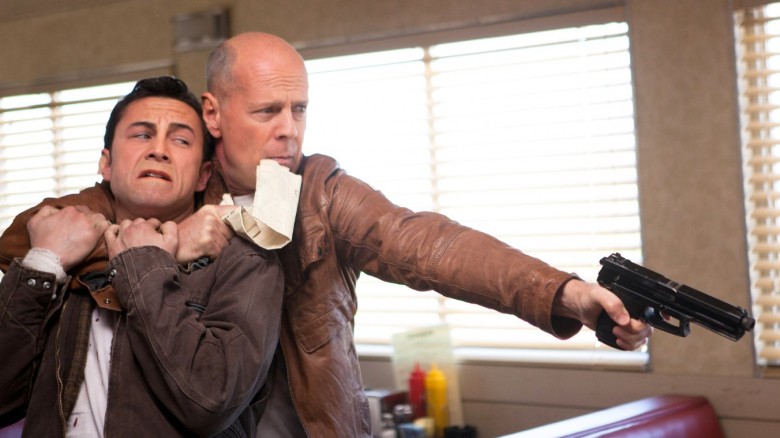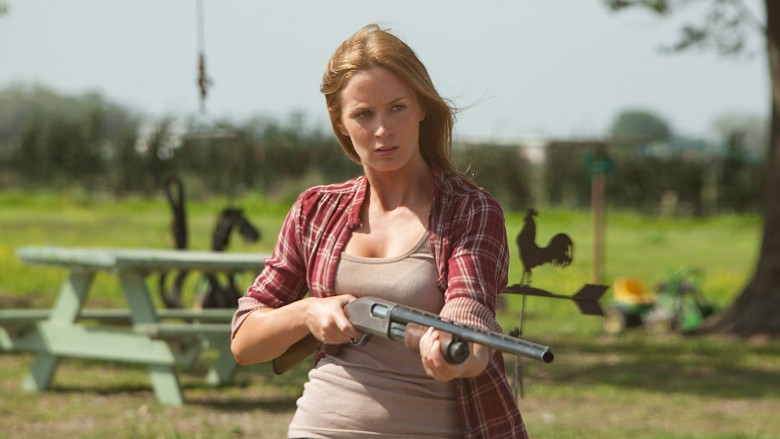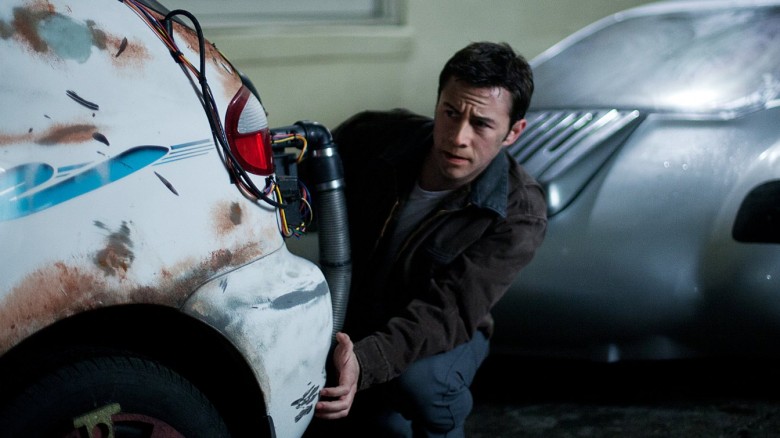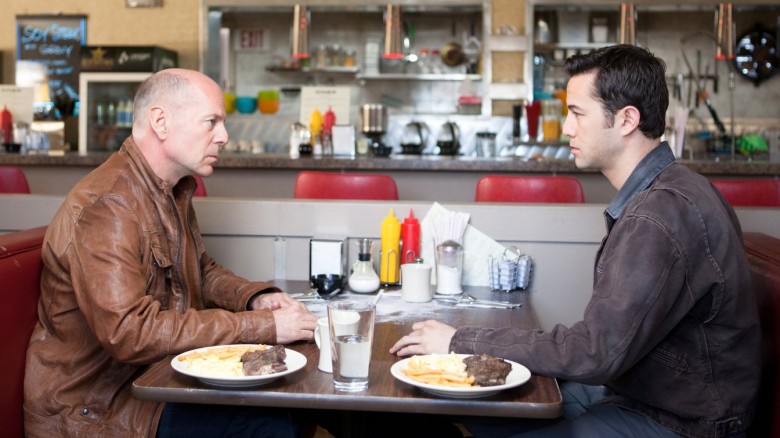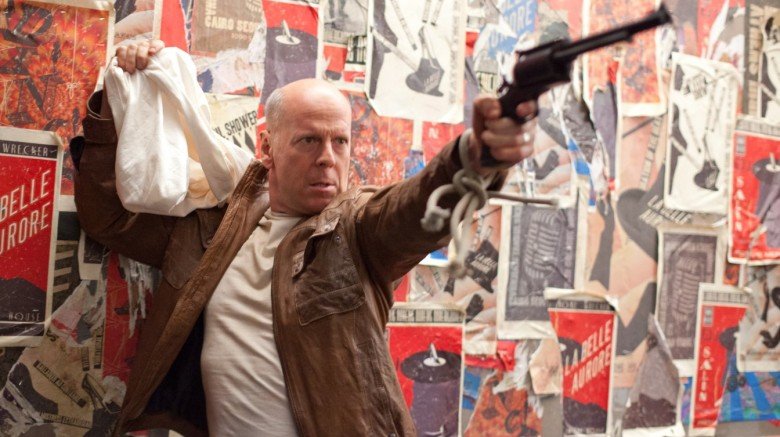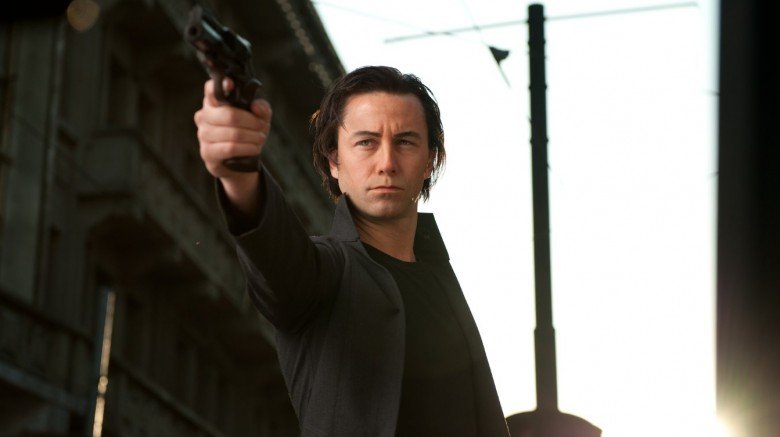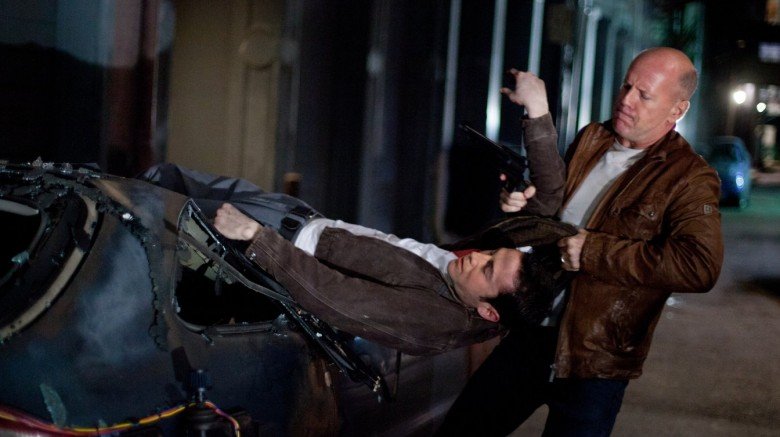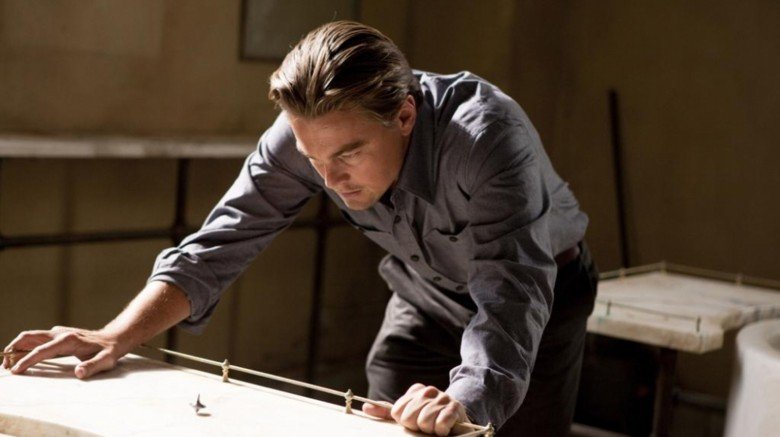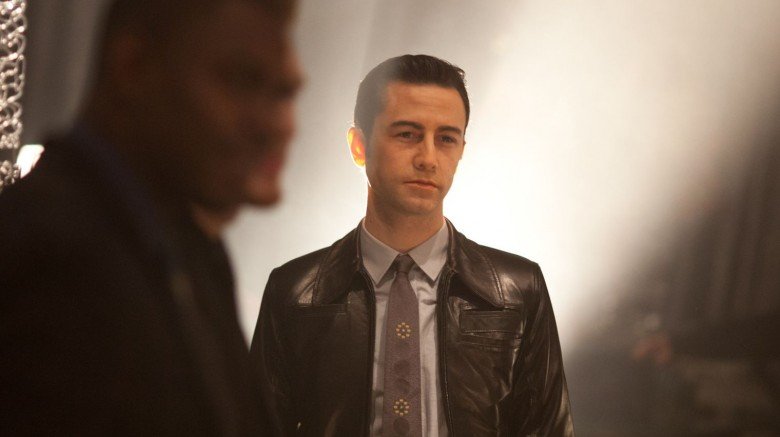The Untold Truth Of Looper
No, this isn't a look behind the scenes of the website you're reading right now. We're peering into the past of Rian Johnson's sci-fi flick Looper—one of the best movies of 2012, genre or otherwise, boasting a spot of honor on several "best of the year" lists and earning a tidy sum at the box office.
In this timey-wimey action film, Joseph Gordon-Levitt and Bruce Willis play young and older versions of the same character, an assassin named Joe who's ordered to kill his future self. Its a twisty thriller that tackles the tricky questions of fate and free will, but the behind-the-scenes stories are arguably just as interesting as the film itself. From humble beginnings in Johnson's notebook to last minute rewrites as part of a deal with Chinese financiers, here's the untold truth of Looper.
Gordon-Levitt went hardcore method to channel young Bruce Willis
Playing a younger version of Bruce Willis is a tall order, and Joseph Gordon-Levitt took it very seriously. The star said he studied Willis's performances almost religiously, and the veteran actor helped out by recording some of Gordon-Levitt's lines, allowing the younger man to hear how Willis might deliver them. However, there was a method to Gordon-Levitt's madness, especially in regards to which Willis performances he drew from. Instead of watching flicks with a young Willis, like Die Hard, Gordon-Levitt focused on films like Sin City. Why? Well, he was trying to find a way to play a young version of the modern-day Willis, instead of mimicking the man from the past. It was a "slight distinction," according to director Rian Johnson, but an important one when it came to figuring out what makes Joe (both new and old) tick.
Sony hid the family aspect during marketing
If you watched the trailers and thought Looper was a tense, sci-fi thriller, you were only half right. Though a good bit of the story finds Willis and Gordon-Levitt slugging it out, the real heart of the narrative is a family story about a young woman (Emily Blunt) and her son, a little boy who may or may not grow up to be a murderous gangster. But you wouldn't really know that from the marketing campaign. Johnson said Sony shied away from those aspects because it's a bit harder to sell those elements in a poster or two-minute trailer. However, the director didn't receive any pushback from the studio in regards to the actual story. And according to Willis, the marketing campaign was actually pretty smart, as viewers would be pleasantly surprised by the dramatic family story since it wasn't over-explained in the trailers.
The film started as a four-page sketch in 2002
While the film hit theaters in 2012, Rian Johnson actually came up with the idea for Looper back in 2002. At first, it was supposed to be a short film, and Johnson worked out his initial idea in a little four-page draft. It took a decade, but those sketches would eventually become the time travel flick we all know and love. Interestingly, the original draft didn't include much of the twisty thriller aspects regarding the Rainmaker (which makes sense, considering it's just four pages), but the crux of Joe's story is still all there. It's a very different story, but it's still pretty darn good on its own. In fact, you can read it right here.
The diner is very authentic
One of the most memorable scenes in Looper involves a not-so-friendly meal at an old-timey diner. It's here that Old Joe and Young Joe finally get a little face time, allowing Gordon-Levitt to learn a thing or two about table manners. Amazingly, this little, rural diner that was featured so heavily in the trailers was actually constructed as a full-sized set in Napoleonville, Louisiana. Crazier still, locals thought someone was building a real diner in town and often dropped by to see when it would be open. Sadly, according to the word on the web, the set was torn down back in 2014, so you'll need a time machine if you want to visit this piece of sci-fi history.
They actually toned down the sci-fi elements
Rian Johnson had a whole lot of fun making a mid-budget sci-fi film, but he had to check himself a few times during production to make sure things didn't go overboard. Considering how much effects work has evolved over the years, Johnson said it was easy to look at the mock-ups from the VFX team and want to jump all the way down that rabbit hole. But the director had to have the discipline to say, "Well that looks really cool, but let's pull that way back....Let's make [the architecture] closer to the original buildings." He also said he drew inspiration from Children of Men and Blade Runner (not to mention a few classic westerns like Shane), hoping to make sure his future was as "near-future" as possible.
They cut a deal with China
Everybody wants to travel the world, even futuristic hit men, and Joe eventually winds up in China. However, the assassin was originally supposed to travel to Paris, but after crunching the numbers, Rian Johnson realized it would be impossible to actually fly to France and shoot the necessary scenes. Suddenly in a bind, the director considered faking the scenes at his Louisiana shooting site, a move that "put a dagger in [Johnson's] heart." After all, he didn't want to sell those key scenes short.
However, that's when the film's Chinese distributor, DMG, stepped in with a proposition. If Johnson moved the scenes to Shanghai, DMG would help foot the bill. So Johnson basically did a find/replace on the script to change shooting locations, then jumped on a plane for Asia. And when rumors began spreading that the script had been rewritten to please Chinese censors, Johnson said "not word" had been changed, except for switching out "Paris" for "Shanghai."
An axed scene explains why you close your own loop
Having someone "close their own loop" is a critical part of the film's world-building, but it's not something Johnson explicitly explained in the film itself. But that doesn't mean he didn't have all the details worked out. As Johnson told Slashfilm, he actually conceived a scene that would've had the character Abe (Jeff Daniels) explain why it's so necessary. Unfortunately, that scene never actually made it in front of the camera.
So why does Young Joe need to bump off his older self? Well, according to Johnson, people in the future are pretty worried about screwing up the timeline, so they're desperately "trying to keep it as tight as possible." The director further elaborated, saying, "So the initial reason they set it up this way was to keep the causality loop as tight as possible. Every bit of evidence is gone from that loop when you kill yourself."
Wow, that kind of stuff could give you a headache. Maybe Old Joe had it right when he said we shouldn't talk about time travel because we'd totally spend all day making Venn diagrams, trying to figure it out.
Christopher Nolan helped make the movie happen
Christopher Nolan's twisty dream thriller Inception opened two years before Looper and became a major critical and commercial hit. In fact, it was Inception's success that led Johnson to realize there was definitely room in the world for a movie like Looper. According to the director, the Leonardo DiCaprio flick was a "revelation" for him, and he saw it as proof that a wide audience would accept a complex movie if it's made well. Basically, Johnson credits Christopher Nolan for giving him permission to mix "eye candy" with a story that audiences could "really chew on," thus making an "important" film that felt like the summer blockbusters Johnson saw as a kid. So as diehard sci-fi fans, we all want to thank Nolan and his spinning top for giving us two amazing movies.
The makeup artists almost gave up on Joseph Gordon-Levitt
The makeup team did an excellent job of blending it in, but Joseph Gordon-Levitt is sporting some major prosthetics to make him look like a young Bruce Willis. And as you might've guessed, this process wasn't an easy one. The film's makeup artists, Jamie Kelman and Kazu Tsuji, initially thought it would be "impossible" to make the two actors look even remotely similar. After all, the stars have such different types of faces with few tangible similarities. The disparity was so big that Kelman and Tsuji almost quite the film entirely, but Johnson insisted they stay on and try to figure out the problem. So the duo spent around two months coming up with the prosthetics for Gordon-Levitt's new look, and the process was so extensive that it took almost three hours each morning to get the actor's makeup on. Yep, three hours every single day, and that's not even mentioning the 50 pairs of fake lips they went through during shooting. It's a good thing Gordon-Levitt is such a trooper because that much time in the makeup chair is enough to make any kid blue.

